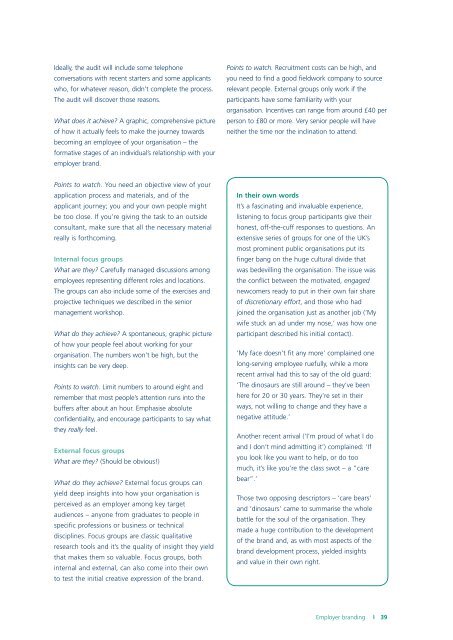Employer branding A no-nonsense approach - CIPD
Employer branding A no-nonsense approach - CIPD
Employer branding A no-nonsense approach - CIPD
Create successful ePaper yourself
Turn your PDF publications into a flip-book with our unique Google optimized e-Paper software.
Ideally, the audit will include some telephone<br />
conversations with recent starters and some applicants<br />
who, for whatever reason, didn’t complete the process.<br />
The audit will discover those reasons.<br />
What does it achieve? A graphic, comprehensive picture<br />
of how it actually feels to make the journey towards<br />
becoming an employee of your organisation – the<br />
formative stages of an individual’s relationship with your<br />
employer brand.<br />
Points to watch. You need an objective view of your<br />
application process and materials, and of the<br />
applicant journey; you and your own people might<br />
be too close. If you’re giving the task to an outside<br />
consultant, make sure that all the necessary material<br />
really is forthcoming.<br />
Internal focus groups<br />
What are they? Carefully managed discussions among<br />
employees representing different roles and locations.<br />
The groups can also include some of the exercises and<br />
projective techniques we described in the senior<br />
management workshop.<br />
What do they achieve? A spontaneous, graphic picture<br />
of how your people feel about working for your<br />
organisation. The numbers won’t be high, but the<br />
insights can be very deep.<br />
Points to watch. Limit numbers to around eight and<br />
remember that most people’s attention runs into the<br />
buffers after about an hour. Emphasise absolute<br />
confidentiality, and encourage participants to say what<br />
they really feel.<br />
External focus groups<br />
What are they? (Should be obvious!)<br />
What do they achieve? External focus groups can<br />
yield deep insights into how your organisation is<br />
perceived as an employer among key target<br />
audiences – anyone from graduates to people in<br />
specific professions or business or technical<br />
disciplines. Focus groups are classic qualitative<br />
research tools and it’s the quality of insight they yield<br />
that makes them so valuable. Focus groups, both<br />
internal and external, can also come into their own<br />
to test the initial creative expression of the brand.<br />
Points to watch. Recruitment costs can be high, and<br />
you need to find a good fieldwork company to source<br />
relevant people. External groups only work if the<br />
participants have some familiarity with your<br />
organisation. Incentives can range from around £40 per<br />
person to £80 or more. Very senior people will have<br />
neither the time <strong>no</strong>r the inclination to attend.<br />
In their own words<br />
It’s a fascinating and invaluable experience,<br />
listening to focus group participants give their<br />
honest, off-the-cuff responses to questions. An<br />
extensive series of groups for one of the UK’s<br />
most prominent public organisations put its<br />
finger bang on the huge cultural divide that<br />
was bedevilling the organisation. The issue was<br />
the conflict between the motivated, engaged<br />
newcomers ready to put in their own fair share<br />
of discretionary effort, and those who had<br />
joined the organisation just as a<strong>no</strong>ther job (‘My<br />
wife stuck an ad under my <strong>no</strong>se,’ was how one<br />
participant described his initial contact).<br />
‘My face doesn’t fit any more’ complained one<br />
long-serving employee ruefully, while a more<br />
recent arrival had this to say of the old guard:<br />
‘The di<strong>no</strong>saurs are still around – they’ve been<br />
here for 20 or 30 years. They’re set in their<br />
ways, <strong>no</strong>t willing to change and they have a<br />
negative attitude.’<br />
A<strong>no</strong>ther recent arrival (‘I’m proud of what I do<br />
and I don’t mind admitting it’) complained: ‘If<br />
you look like you want to help, or do too<br />
much, it’s like you’re the class swot – a “care<br />
bear”.’<br />
Those two opposing descriptors – ‘care bears’<br />
and ‘di<strong>no</strong>saurs’ came to summarise the whole<br />
battle for the soul of the organisation. They<br />
made a huge contribution to the development<br />
of the brand and, as with most aspects of the<br />
brand development process, yielded insights<br />
and value in their own right.<br />
<strong>Employer</strong> <strong>branding</strong>

















